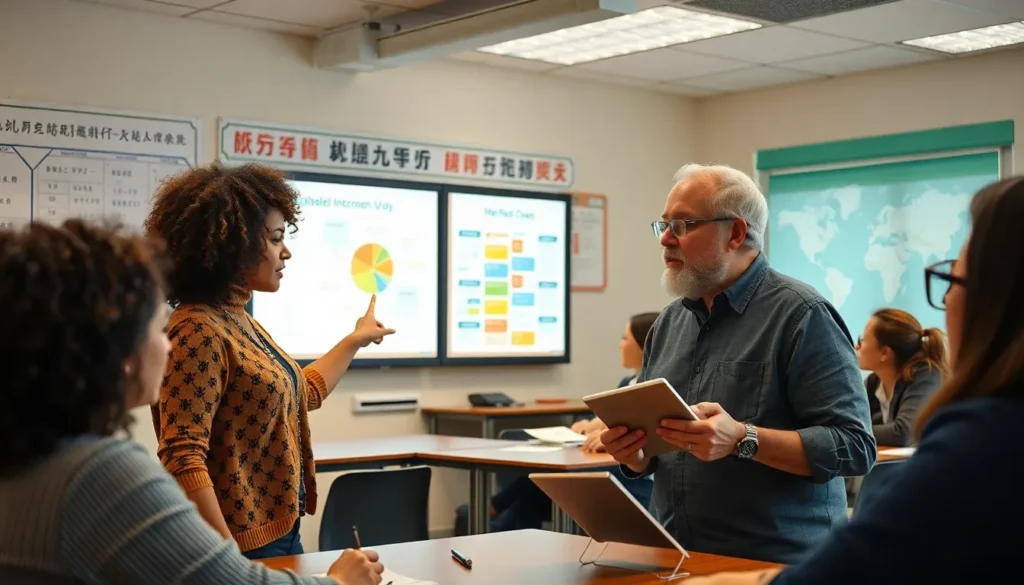Table of Contents
ToggleIn a world where communication is key, mastering language support techniques can feel like having a secret superpower. Whether it’s helping someone navigate a tricky conversation or ensuring everyone feels included in discussions, these techniques are the unsung heroes of effective communication. Imagine being the person who can turn a language barrier into a bridge—now that’s a skill worth having!
Overview of Language Support Techniques
Language support techniques play a crucial role in effective communication. These methods assist individuals in overcoming language barriers, ensuring clarity in conversations.
Translation services offer real-time language exchanges. Many organizations employ interpreters who facilitate interactions between speakers of different languages. This approach fosters understanding and allows all participants to contribute fully.
Visual aids enhance comprehension. Using pictures, charts, or infographics can clarify complex concepts. Such tools also help those with varying language proficiencies grasp essential information more easily.
Simplified language promotes accessibility. By using plain language, speakers make content more relatable. Clarity is key; avoiding jargon and technical terms empowers individuals to engage with the material without confusion.
Technology-driven resources support diverse language needs. Mobile apps and software provide translation and learning tools. These resources cater to users across different linguistic backgrounds, enabling seamless communication.
Cultural sensitivity improves interactions significantly. Recognizing and respecting cultural differences fosters an inclusive environment. Understanding cultural context leads to more meaningful conversations and builds stronger relationships.
Collaborative platforms enhance language support through collective learning. Group discussions allow participants to share knowledge and experiences. Such exchanges promote language proficiency while creating support networks among diverse individuals.
Implementing these techniques facilitates effective communication across various settings. Environments that embrace inclusivity and adaptability see improved interactions and stronger connections.
Types of Language Support Techniques

Language support techniques include various methods that enhance communication by addressing different needs. These techniques provide clarity and foster understanding among diverse populations.
Visual Support Techniques
Visual support techniques utilize images, charts, and infographics to convey information. These tools help clarify complex ideas and engage audiences more effectively. Illustrations can simplify challenging content, making it accessible to individuals with varying language proficiencies. Using signage in multiple languages also guides those unfamiliar with the primary language. Employing color-coded systems enhances comprehension and retention, as visuals often resonate more than text alone. Multimedia presentations combine visual elements and spoken content for a dynamic learning experience.
Audio Support Techniques
Audio support techniques focus on verbal communication methods to assist language comprehension. Utilizing audio recordings can reinforce learning, especially for auditory learners. Pronunciation guides in audio format help individuals practice and improve their speaking skills. Podcasts covering relevant topics allow listeners to absorb information at their convenience. Interactive language apps often include audio features that promote immersion and real-time practice. With these techniques, learners can develop a stronger grasp of language nuances through listening and repetition.
Benefits of Language Support Techniques
Language support techniques provide numerous advantages that enhance communication and inclusivity. These benefits include improved comprehension and increased engagement in conversations.
Enhancing Comprehension
Comprehension improves significantly with language support techniques. Visual aids clarify complex ideas, allowing participants to grasp information easily. Simplified language terms ensure that messages resonate, particularly with those who may struggle with jargon. Translation services bridge gaps, enabling immediate understanding across different languages. Interpreters also enhance this process by providing real-time assistance during conversations. Such strategies lead to a more inclusive environment, fostering effective interactions.
Promoting Engagement
Engagement rises when language support techniques are implemented. Participants feel more confident when they understand the conversation fully. Active involvement increases as individuals grasp the nuances of discussions. Collaborative tools, such as language apps, invite users to practice skills collectively, promoting teamwork. Utilizing multiple languages in signage or materials invites wider participation from diverse audiences. Techniques that prioritize clarity and accessibility create a supportive atmosphere where everyone contributes.
Challenges in Implementing Language Support Techniques
Implementing language support techniques poses several challenges. These obstacles can hinder effective communication and inclusivity.
Resource Limitations
Many organizations face budgetary constraints that affect the availability of resources. Limited funds may restrict access to necessary translation services or professional interpreters. Furthermore, specialized technology may not be affordable for all institutions. Inadequate resources can lead to reliance on less effective tools, impacting overall comprehension. Some communities lack access to multilingual materials that enhance understanding. These resource limitations prevent optimal implementation of language support techniques, impeding clear communication in diverse settings.
Teacher Training
Effective teacher training plays a crucial role in the successful adoption of language support techniques. Many educators lack formal training in language instruction, limiting their ability to assist students effectively. Furthermore, ongoing professional development opportunities may be scarce. Teachers need comprehensive training that covers various language support techniques, ensuring they remain confident and competent in diverse classrooms. Additionally, educators should be equipped with strategies to address cultural sensitivities, fostering an inclusive learning environment. Without proper training, the implementation of language support techniques can fall short, hampering communication and learning progress.
Future Trends in Language Support Techniques
Innovations in language support techniques focus on integrating advanced technologies. Artificial intelligence plays a pivotal role in enhancing translation accuracy and real-time communication. Tools utilizing machine learning improve interactions by analyzing and adapting to user preferences.
Remote interpreting services are gaining traction, ensuring access to language support regardless of location. Mobile applications facilitate on-the-go assistance, bridging language gaps during travel or emergency situations. These developments promote inclusivity by providing immediate solutions to communication challenges.
Collaboration platforms continue to evolve, fostering peer-to-peer learning and resource sharing among multilingual individuals. Communities can leverage these networks to enhance language skills collectively. Such environments encourage diverse perspectives, enriching conversations and fostering deeper connections.
Emerging trends also emphasize cultural competence training. Understanding cultural contexts equips individuals to navigate language nuances effectively. Organizations are prioritizing this training to create more inclusive workplaces and improve client relations.
Data analytics are being used to customize language support resources better. By tracking usage patterns, organizations can tailor their strategies to specific audiences, maximizing impact. This approach ensures that techniques resonate with learners, enhancing engagement and retention.
As voice recognition technology improves, so does its application in language support. Speech-to-text applications help users with hearing impairments or those learning new languages. These tools support diverse learners, ensuring that everyone has equal opportunities for communication.
Lastly, immersive language experiences, such as virtual reality, are emerging as a trendy method for enhancing language acquisition. Simulation environments allow users to practice language skills in realistic settings, increasing confidence and fluency. Integrating these trends into language support techniques sets the stage for more effective communication across various platforms.
Mastering language support techniques is vital for effective communication in today’s diverse world. These strategies not only enhance comprehension but also foster inclusive environments where everyone feels valued. By utilizing visual and audio methods alongside technology-driven resources, individuals can bridge language gaps and promote engagement.
As organizations embrace cultural competence and innovative tools, the potential for improved interactions grows. Investing in training and resources ensures that language support techniques are effectively implemented, paving the way for stronger connections among diverse populations. Embracing these approaches ultimately leads to richer conversations and a more inclusive society.




